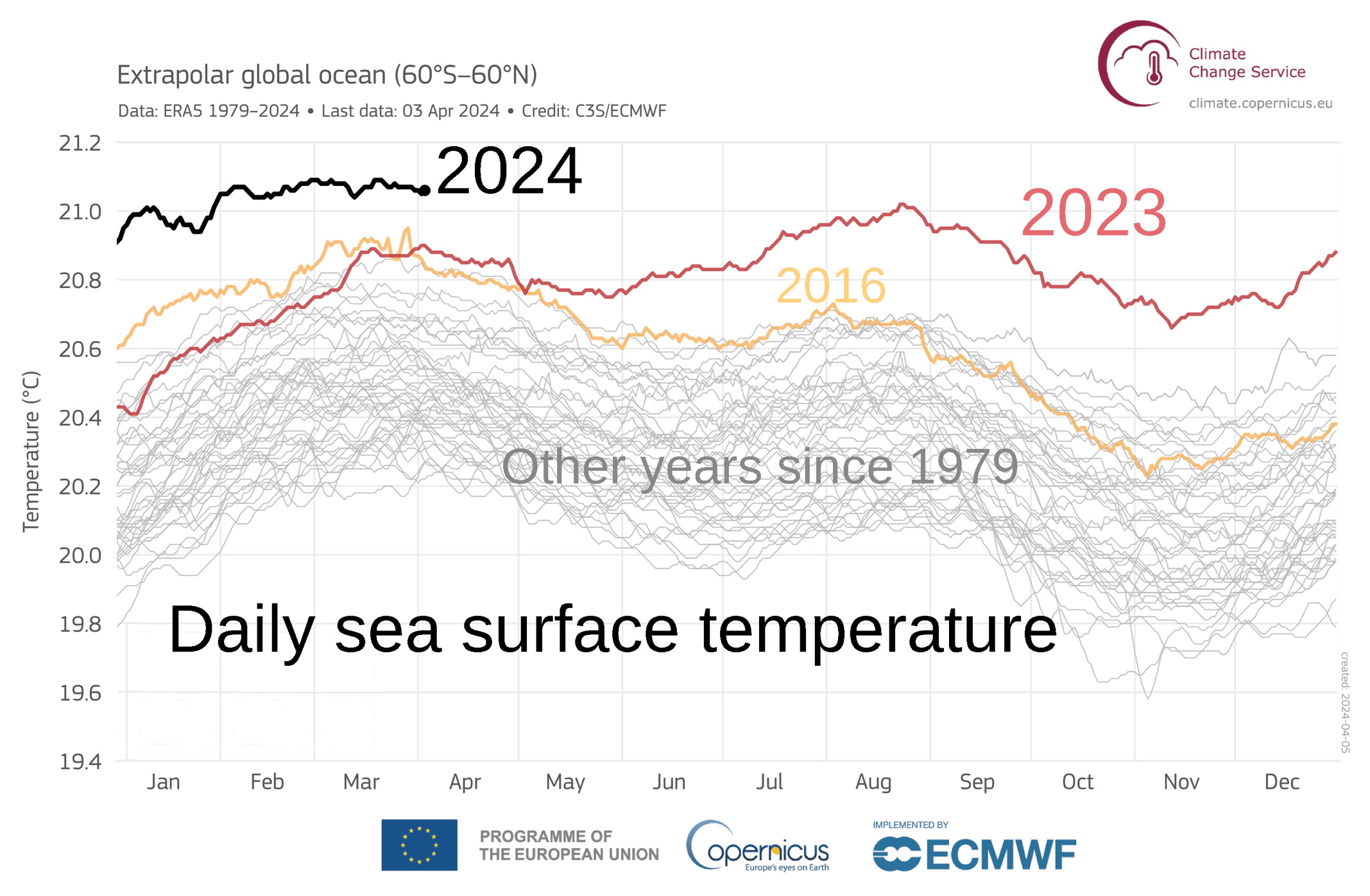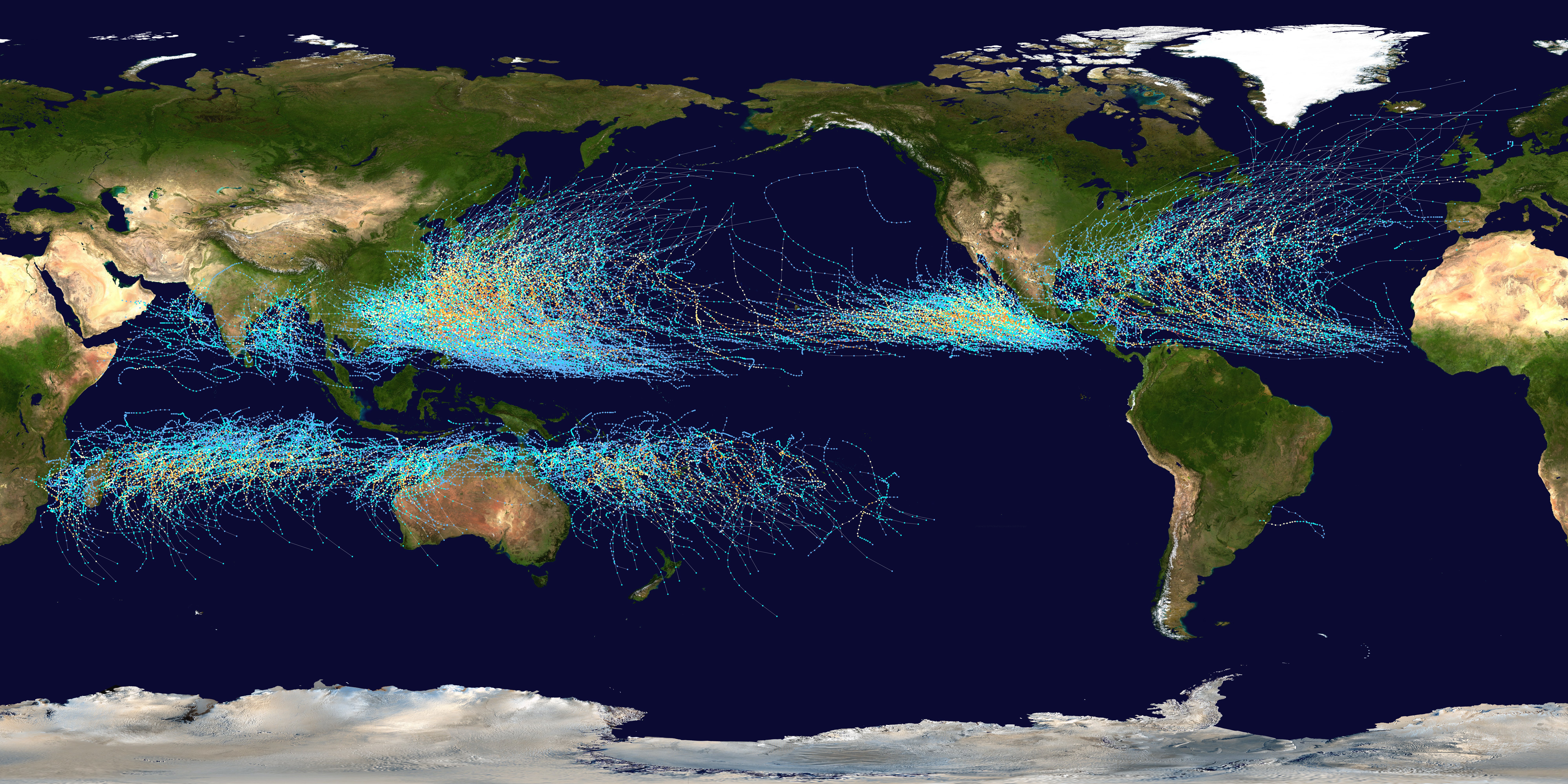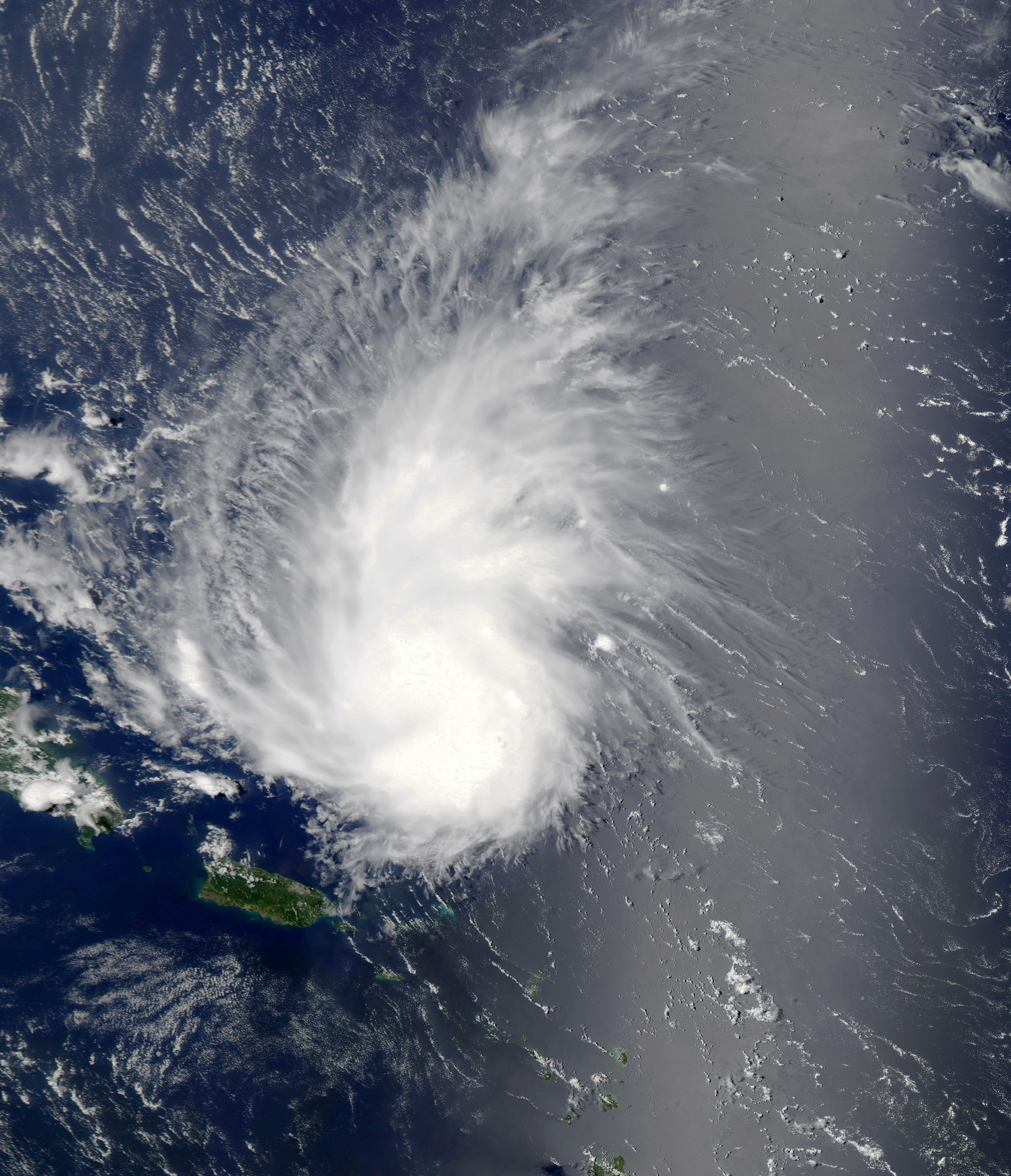|
Hurricane Hilda
Hurricane Hilda was a powerful tropical cyclone that ravaged areas of the United States Gulf Coast, particularly Louisiana. In addition to its damage inland, the hurricane greatly disrupted offshore oil production, and at its time was the costliest tropical cyclone for Louisiana's offshore oil production. Due in part to flights made by the National Hurricane Research Laboratory, Hilda became one of the most well-documented storms meteorologically in the Atlantic. Lasting for seven days as a tropical cyclone, Hilda caused US$126 million in damage and 38 deaths. It was the tenth named storm, sixth hurricane, and the fourth major hurricane of the 1964 Atlantic hurricane season. Hilda developed over the southern shores of Cuba on September 28 as a tropical depression, tracking westward in an area of favorable conditions and reaching tropical storm intensity the next day. Once situated in the Gulf of Mexico, Hilda strengthened into a hurricane and began a slow trawl ... [...More Info...] [...Related Items...] OR: [Wikipedia] [Google] [Baidu] |
Cuba
Cuba, officially the Republic of Cuba, is an island country, comprising the island of Cuba (largest island), Isla de la Juventud, and List of islands of Cuba, 4,195 islands, islets and cays surrounding the main island. It is located where the northern Caribbean Sea, Gulf of Mexico, and Atlantic Ocean meet. Cuba is located east of the Yucatán Peninsula (Mexico), south of both Florida and the Bahamas, west of Hispaniola (Haiti/Dominican Republic), and north of Jamaica and the Cayman Islands. Havana is the largest city and capital. Cuba is the List of countries and dependencies by population, third-most populous country in the Caribbean after Haiti and the Dominican Republic, with about 10 million inhabitants. It is the largest country in the Caribbean by area. The territory that is now Cuba was inhabited as early as the 4th millennium BC, with the Guanahatabey and Taino, Taíno peoples inhabiting the area at the time of Spanish colonization of the Americas, Spanish colonization ... [...More Info...] [...Related Items...] OR: [Wikipedia] [Google] [Baidu] |
Landfall (meteorology)
Landfall is the event of a storm moving over land after being over water. More broadly, and in relation to human travel, it refers to 'the first land that is reached or seen at the end of a journey across the sea or through the air, or the fact of arriving there.' Tropical cyclone A tropical cyclone is classified as making landfall when the center of the storm moves across the coast; in a relatively strong tropical cyclone, this is when the center of its eye (cyclone), eye moves over land. This is where most of the damage occurs within a mature tropical cyclone, such as a typhoon or hurricane, as most of the damaging aspects of these systems are concentrated near the eyewall. Such effects include the peaking of the storm surge, the core of strong winds coming ashore, and heavy flooding Rain, rains. These coupled with high surf can cause major coastal erosion, beach erosion. When a tropical cyclone makes landfall, the eye usually closes in upon itself due to negative environ ... [...More Info...] [...Related Items...] OR: [Wikipedia] [Google] [Baidu] |
Sea Surface Temperature
Sea surface temperature (or ocean surface temperature) is the ocean temperature, temperature of ocean water close to the surface. The exact meaning of ''surface'' varies in the literature and in practice. It is usually between and below the sea surface. Sea surface temperatures greatly modify air masses in the Atmosphere of Earth, Earth's atmosphere within a short distance of the shore. The thermohaline circulation has a major impact on average sea surface temperature throughout most of the world's oceans. Warm sea surface temperatures can develop and Tropical cyclogenesis, strengthen cyclones over the ocean. Tropical cyclones can also cause a cool wake. This is due to turbulent mixing of the upper of the ocean. Sea surface temperature changes during the day. This is like the air above it, but to a lesser degree. There is less variation in sea surface temperature on breezy days than on calm days. Coastal sea surface temperatures can cause offshore winds to generate upwelling ... [...More Info...] [...Related Items...] OR: [Wikipedia] [Google] [Baidu] |
Tropical Cyclogenesis
Tropical cyclogenesis is the development and strengthening of a tropical cyclone in the atmosphere. The mechanisms through which tropics, tropical cyclogenesis occur are distinctly different from those through which temperate cyclogenesis occurs. Tropical cyclogenesis involves the development of a warm core, warm-core cyclone, due to significant convection in a favorable atmospheric environment. Tropical cyclogenesis requires six main factors: sufficiently warm sea surface temperatures (at least ), atmospheric instability, high humidity in the lower to middle levels of the troposphere, enough Coriolis force to develop a low-pressure area, low-pressure center, a pre-existing low-level focus or disturbance, and low vertical wind shear. Tropical cyclones tend to develop during the summer, but have been noted in nearly every month in tropical cyclone basins, most basins. Climate cycles such as ENSO and the Madden–Julian oscillation modulate the timing and frequency of tropical c ... [...More Info...] [...Related Items...] OR: [Wikipedia] [Google] [Baidu] |
Yucatán Channel
The Yucatán Channel or Straits of Yucatán (Spanish: ''Canal de Yucatán'') is a strait between Mexico and Cuba. It connects the Yucatán Basin of the Caribbean Sea with the Gulf of Mexico. It is just over wide and nearly deep at its deepest point near the coast of Cuba. Currents The Yucatán Channel separates Cuba from the Yucatán Peninsula of Mexico and links the Caribbean Sea with the Gulf of Mexico. The strait is across between Cape Catoche in Mexico and Cape San Antonio in Cuba. It has a maximum depth near the Cuban coast of . Water flows through the Caribbean Sea from east to west. This flow consists of 5 Sv of water from the North Equatorial Current flowing through the Windward Passage and 12 Sv of water from the South Equatorial Current which flows along the coast of Brazil. The total flow is about 17 Sv at a temperature of at least . When this water flows past the Yucatán Peninsula it becomes the Yucatán Current. This current provides most of the inflow of water i ... [...More Info...] [...Related Items...] OR: [Wikipedia] [Google] [Baidu] |
Cape San Antonio, Cuba
Cape San Antonio (), is a cape which forms the western extremity of the Guanahacabibes Peninsula and the western extremity of Cuba. It extends into the Yucatán Channel, and is part of the municipality of Sandino, in Pinar del Río Province. According to the International Hydrographic Organization, the line between the lighthouse at Cabo Catoche on the north tip of the Yucatán Peninsula in Mexico and the lighthouse at Cape San Antonio marks the division between the Caribbean Sea to the south and Gulf of Mexico to the north. See also * Cape Maisí * Cape Corrientes * Cabo San Antonio Lighthouse References External links Cape San Antonio on havanajournal.com San Antonio San Antonio ( ; Spanish for " Saint Anthony") is a city in the U.S. state of Texas and the most populous city in Greater San Antonio. San Antonio is the third-largest metropolitan area in Texas and the 24th-largest metropolitan area in the ... Sandino, Cuba Geography of Pinar del Río Provin ... [...More Info...] [...Related Items...] OR: [Wikipedia] [Google] [Baidu] |
Haiti
Haiti, officially the Republic of Haiti, is a country on the island of Hispaniola in the Caribbean Sea, east of Cuba and Jamaica, and south of the Bahamas. It occupies the western three-eighths of the island, which it shares with the Dominican Republic. Haiti is the third largest country in the Caribbean, and with an estimated population of 11.4 million, is the most populous Caribbean country. The capital and largest city is Port-au-Prince. Haiti was originally inhabited by the Taíno people. In 1492, Christopher Columbus established the first European settlement in the Americas, La Navidad, on its northeastern coast. The island was part of the Spanish Empire until 1697, when the western portion was Peace of Ryswick, ceded to France and became Saint-Domingue, dominated by sugarcane sugar plantations in the Caribbean, plantations worked by enslaved Africans. The 1791–1804 Haitian Revolution made Haiti the first sovereign state in the Caribbean, the second republic in the Americ ... [...More Info...] [...Related Items...] OR: [Wikipedia] [Google] [Baidu] |
Convection (meteorology)
Atmospheric convection is the vertical transport of heat and moisture in the atmosphere. It occurs when warmer, less dense air rises, while cooler, denser air sinks. This process is driven by Air parcel, parcel-environment instability, meaning that a "parcel" of air is warmer and less dense than the surrounding environment at the same altitude. This difference in temperature and density (and sometimes humidity) causes the parcel to rise, a process known as buoyancy. This rising air, along with the compensating sinking air, leads to mixing, which in turn expands the height of the planetary boundary layer (PBL), the lowest part of the atmosphere directly influenced by the Earth's surface. This expansion contributes to increased Wind, winds, cumulus cloud development, and decreased surface Dew point, dew points (the temperature below which condensation occurs). Convection plays a crucial role in weather patterns, influencing cloud formation, wind, and the development of Thunderstor ... [...More Info...] [...Related Items...] OR: [Wikipedia] [Google] [Baidu] |
Lesser Antilles
The Lesser Antilles is a group of islands in the Caribbean Sea, forming part of the West Indies in Caribbean, Caribbean region of the Americas. They are distinguished from the larger islands of the Greater Antilles to the west. They form an arc which begins east of Geography of Puerto Rico, Puerto Rico at the Virgin Islands, archipelago of the Virgin Islands, swings southeast through the Leeward Islands, Leeward and Windward Islands towards South America, and turns westward through the Leeward Antilles along the Geography of Venezuela, Venezuelan coast. Most of them are part of a long, partially volcanic arc, volcanic island arc between the Greater Antilles to the north-west and the continent of South America."West Indies." ''Merriam-Webster's Geographical Dictionary'', 3rd ed. 2001. () Springfield, MA: Merriam-Webster Inc., p. 1298. The islands of the Lesser Antilles form the eastern boundary of the Caribbean Sea where it meets the Atlantic Ocean. Together, the Lesser Antilles a ... [...More Info...] [...Related Items...] OR: [Wikipedia] [Google] [Baidu] |
Caribbean Sea
The Caribbean Sea is a sea of the Atlantic Ocean, North Atlantic Ocean in the tropics of the Western Hemisphere, located south of the Gulf of Mexico and southwest of the Sargasso Sea. It is bounded by the Greater Antilles to the north from Cuba to Puerto Rico, the Lesser Antilles to the east from the Virgin Islands to Trinidad and Tobago, South America to the south from the Venezuela, Venezuelan coastline to the Colombia, Colombian coastline, and Central America and the Yucatán Peninsula to the west from Panama to Mexico. The Geopolitics, geopolitical region around the Caribbean Sea, including the numerous islands of the West Indies and adjacent coastal areas in the mainland of the Americas, is known as the Caribbean. The Caribbean Sea is one of the largest seas on Earth and has an area of about . The sea's deepest point is the Cayman Trough, between the Cayman Islands and Jamaica, at below sea level. The Caribbean coastline has many gulfs and bays: the Gulf of Gonâve, the Gul ... [...More Info...] [...Related Items...] OR: [Wikipedia] [Google] [Baidu] |
Tropical Wave
A tropical wave (also called easterly wave, tropical easterly wave, and African easterly wave), in and around the Atlantic Ocean, is a type of atmospheric trough, an elongated area of relatively low air pressure, oriented north to south, which moves from east to west across the tropics, causing areas of cloudiness and thunderstorms. Tropical waves form in the easterly flow along the equatorial side of the subtropical ridge or belt of high air pressure which lies north and south of the Intertropical Convergence Zone (ITCZ). Tropical waves are generally carried westward by the prevailing easterly winds along the tropics and subtropics near the equator. They can lead to the formation of tropical cyclones in the north Atlantic and northeastern Pacific basins. A tropical wave study is aided by Hovmöller diagrams, a graph of meteorological data. West-moving waves can also form from the tail end of frontal zones in the subtropics and tropics, and may be referred to as easterly ... [...More Info...] [...Related Items...] OR: [Wikipedia] [Google] [Baidu] |
Mid-Atlantic States
The Mid-Atlantic is a region of the United States located in the overlap between the nation's Northeastern and Southeastern states. Traditional definitions include seven U.S. states: New York, New Jersey, Pennsylvania, Delaware, Maryland, Virginia, West Virginia, and the national capital of Washington, D.C.. Depending on various factors, different regional divisions exist however: the U.S. Bureau of Labor Statistics in its newest regional division excludes New York from the region; the US Census Bureau excludes Delaware, Maryland, Virginia and West Virginia from the region; USGS defines the region by watersheds thus additionally including North Carolina;Earl A. Greene et al"Ground-Water Vulnerability to Nitrate Contamination in the Mid-Atlantic Region". USGS Fact Sheet FS 2004-3067. 2005. Retrieved April 25, 2013. Note: Although the locator map appears to exclude part of northwestern Pennsylvania, other more detailed maps in this article include all of the state. Often, when ... [...More Info...] [...Related Items...] OR: [Wikipedia] [Google] [Baidu] |






